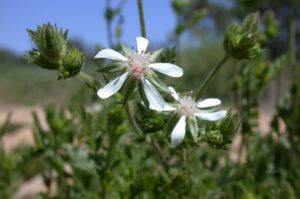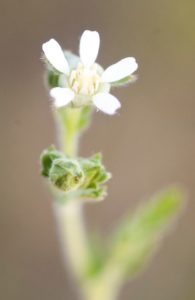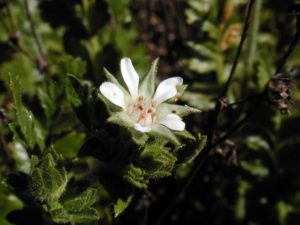Horkelia

Santa Lucia horkelia (Horkelia yadonii) in bloom. Photo © Laura Ann Eliassen
The horkelia is a small flowering plant that belongs to the rosaceae, or rose family. There are nineteen species found in the western United States, most of which are endemic to California. This genus’s most notable characteristics are the dainty white and pink flowers that the plant produces during blooming season. Of the nineteen horkelia species, three can be found in the Los Padres National Forest. The forest provides suitable conditions to three horkelia species, which are considered “sensitive,” meaning that they have been observed to be declining in recent years and are protected by law. One interesting fact about the horkelia is that the Chumash Indians may have made tea from the horkelia roots, called tabardillo, to treat fevers, colds, stomach pains, and the flu, purify the blood, and as a stimulant.
The horkelia faces a variety of threats such as land development in their native range, uprooting by feral pigs, and damage from activities like off-road vehicle trespassing and vegetation clearing. It has been extirpated in many parts of its natural range.
Mesa horkelia
Horkelia cuneata var. puberula
- Sensitive – U.S. Forest Service
- Rare Plant Rank 1B.1 – California Native Plant Society
- T2 Imperiled – NatureServe (2001)

Mesa horkelia (Horkelia cuneata var. puberula) in bloom. Photo © Tony Morosco
The mesa horkelia is distributed along the central to south coast of California, found in San Luis Obispo, Riverside, Santa Barbara, and Los Angeles counties. It once flourished in San Bernardino, San Diego, and Ventura counties as well, but has become locally extinct in these areas. There is only one record of the mesa horkelia occurring in the Los Padres National Forest at Cuesta Ridge. This small plant prefers chaparral, woodland, and coastal scrub habitats. The mesa horkelia subspecies has many fine hairs on its stems and leaves and produces small flowers with five narrow white petals. Its flowering season typically begins in February and ends in September. While very similar in appearance to other horkelia subspecies, the mesa horkelia’s flowers bloom all at once (called “open inflorescence”), unlike other horkelia, whose flowers bloom in a certain order.
Santa Lucia horkelia
Horkelia yadonii
- Sensitive – U.S. Forest Service
- G3 Vulnerable – NatureServe (1997)

Santa Lucia horkelia (Horkelia yadonii) in bloom. Photo © Chris Winchell
The Santa Lucia horkelia grows in Monterey, Santa Barbara, and San Luis Obispo counties within the Los Padres National Forest. This plant has long, soft straight hairs growing on its stems and produces larger flowers and leaves than the Kellogg’s horkelia. The Santa Lucia horkelia’s ideal habitats consist of sandy meadows, chaparral, pine woodland, and riparian woodland, which are actually uncommon within its range, and results in dispersed, somewhat fragmented populations. Of the three horkelia species found in the Los Padres Forest, however, it has large enough populations to potentially avoid extinction for quite some time.
Kellogg’s horkelia
Horkelia cuneata var. sericea
- Sensitive – U.S. Forest Service
- Rare Plant Rank 1B.1 – California Native Plant Society
- T1 Critically Imperiled – NatureServe (2017)
Kellogg’s horkelia is found along the coast of northern and central California in San Mateo, Monterey, Santa Cruz, San Luis Obispo, and Santa Barbara counties. It was also once found in Marin County, Alameda, and San Francisco, but unfortunately has become locally extinct in those locations.

Kellog’s horkelia (Horkelia cuneata var. sericea) in bloom. Photo © 2014 Jay Sullivan. Taken at Burton Mesa area.
It possesses silky hairs that are most noticeable on its leaves. This perennial’s flowering season occurs from April to September, during which small white flowers bloom to attract pollinators. Unlike some other korelia species, Kellogg’s horkelia is a hardy subspecies that prefers sandy and gravelly substrate over richer soils, and grows on coastal dunes, chaparral, and coniferous forests.
Protecting Horkelias in the Los Padres
The horkelia faces threats from unauthorized off-road vehicle (ORV) use, feral pig grazing, land development, and vegetation clearing. ForestWatch carefully monitors activities that would potentially impact these sensitive species by requiring buffers and limiting vegetation clearing projects proposed by the Forest Service. ForestWatch also works to monitor and report illegal off-road vehicle use to protect this and other rare plants.






